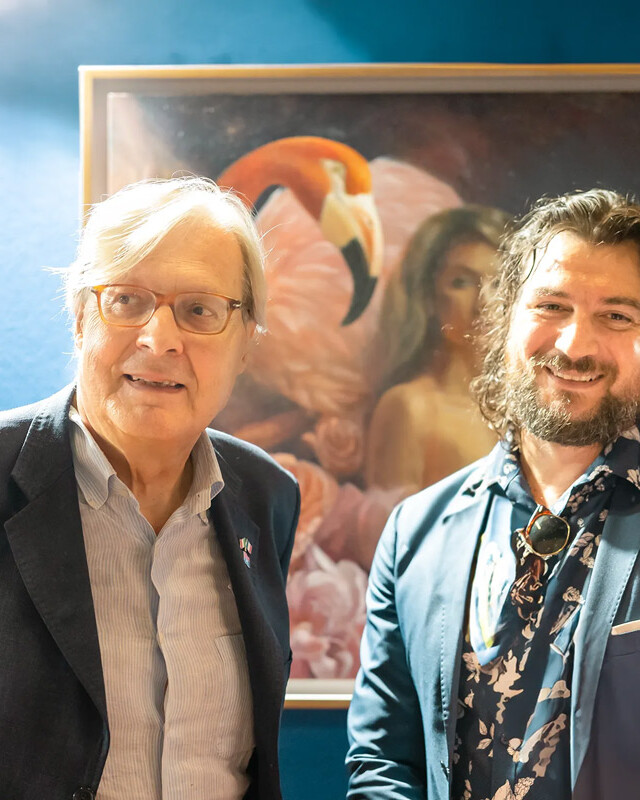I want to introduce a new series of posts. I want to discover again old paintings and make them accessible to all.
Caravaggio’s “Madonna dei Palafrenieri” is a beautiful and thought-provoking painting that showcases the artist’s innovative style and deep understanding of human emotions. Created around 1606, this oil on canvas painting is housed in the Vatican Pinacoteca in Rome, Italy, and continues to captivate art lovers and historians alike with its powerful symbolism and dramatic lighting effects.
Caravaggio Madonna dei Palafrenieri was commissioned by the confraternity of the Palafrenieri, who wanted to place it on an altar in St. Peter’s Basilica in 1606.
Caravaggio was offered only 70 scudi for this work, but despite the low price he accepted, being in a period of hardship, even those few scudi were needed.
The painting depicts the Madonna and Child, a popular subject in art during the Renaissance. However, Caravaggio’s interpretation of this traditional theme is unique and groundbreaking. Unlike many other depictions of the Madonna and Child, the figures in “Madonna dei Palafrenieri” are not idealized or glamorized, but instead are depicted as real, flesh-and-blood people. The Madonna is not a serene and remote goddess, but rather a young woman who looks down at her child with a tender expression of love and concern. Her features are not perfect, but are instead carefully observed and depicted with a remarkable sense of realism. This shift from the idealized to the real is a hallmark of Caravaggio’s style and was highly influential for future artists.
Despite the very low cost of the painting, the work was immediately rejected by the clients for several reasons: the baby Jesus was too big to appear naked, moreover, the Virgin showed a too wide neckline, and then they absolutely did not accept that it was Lena, a prostitute who represented Maria.

Later he was also criticized by Catholics: the attitude of Jesus in stepping on the snake, according to them, seemed almost as if he enjoyed killing the snake.
All these criticisms labeled Caravaggio’s painting as a heretical painting.
Later the painting was sold to the Borghese family for 100 scudi.

Check this painting in ultra-high resolution
In addition to its innovative depiction of the Madonna and Child, “Madonna dei Palafrenieri” is also notable for its dramatic lighting effects. Caravaggio was a master of the art of chiaroscuro, using contrasts of light and dark to create a sense of depth and atmosphere. In this painting, he employs this technique to great effect, casting a bright light on the Madonna and Child and leaving the background in shadow. This creates a sense of intimacy and focus on the central figures, as well as a heightened sense of drama. The stark contrast of light and dark also serves to emphasize the powerful emotions of the Madonna and Child, drawing the viewer’s attention to their expressions and gestures.
Another aspect of “Madonna dei Palafrenieri” that sets it apart from other paintings of the time is its symbolism. The painting’s title, “Madonna dei Palafrenieri,” refers to the palafrenieri, or horsemen, who served in the papal court. This title has led some to interpret the painting as a symbol of the church’s protection of the faithful, with the Madonna and Child representing the church and the palafrenieri serving as its guardians. Additionally, the light in the painting has been seen as a symbol of divine grace, with the Madonna and Child symbolizing the source of that grace.
In conclusion, Caravaggio’s “Madonna dei Palafrenieri” is a masterful work of art that showcases the artist’s innovative style and deep understanding of human emotions. Its unique depiction of the Madonna and Child, dramatic lighting effects, and powerful symbolism continue to captivate audiences and inspire artists to this day. This painting is a testament to Caravaggio’s skill as a painter and his ability to create powerful, thought-provoking works of art that continue to inspire and engage viewers centuries after their creation.
Who is Caravaggio
Caravaggio was an Italian baroque artist known for his dramatic use of light and dark, known as chiaroscuro, in his paintings. Born in Milan in 1571, he spent much of his career working in Rome, where he became known for his realistic and often controversial depictions of religious and classical themes. Caravaggio’s innovative approach to painting, which emphasized the use of light and shadow to create a sense of depth and atmosphere, had a profound impact on the development of baroque art and continues to influence artists to this day.
Despite his success, Caravaggio lived a tumultuous life, plagued by legal troubles and violent behavior, and died at the young age of 38. Nevertheless, his artistic legacy endures, and his works are considered some of the most important and innovative of the baroque period.
This article was last updated on February 9, 2023 by Alex Righetto
This article available in:
About the author
Alex Righetto
Alex Righetto is an Italian artist based in the US, known for his vibrant and bold paintings that reinterpret Italian and European history in a contemporary context. His work has been featured in various exhibitions and publications, including Vanity Fair and Vogue





